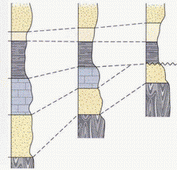Stratigraphy: linking rocks, fossils, and time
Because sedimentary rocks are time transgressive (meaning one unit, such as a sandstone layer, can be deposited throughout time) we need terminology that deals with not only the individual rock types but also the deposition that occurred over a certain periods of time and time itself.
Lithostratigraphic units are used to describe distinctive bodies of rock. These units focus solely on the specific types of rock and have no relation to time or length of time a given rock was deposited. The basic lithostratigraphic element is a formation; a mappable unit of rock with distinctive upper and lower boundaries. These units may consist of a single rock type, like the Redwall Limestone, or may consist of a variety of rock types, such as the Morrison Formation. Formations may be subdivided into smaller units such as members and or beds or may be grouped into larger units called groups or supergroups.
Biostratigraphic units are bodies of strata recognized solely on the basis of fossil content. Since the existence of life in a given area is not necessarily affected by the type of sediment deposited in that area the boundaries of biostratigraphic units do not have to correspond to lithostratigraphic units. The fundamental biostratigraphic unit is the biozone. The range zone is defined by the geologic range (the total time of existence) of a particular fossil group or species. For example the range zone of the fossil graptolites is Ordivician to Devonian. A concurrent range zone is the overlapping range zones of two or more fossils with different geologic ranges.
Time-stratigraphic units (also known as chronostratigraphic units) consists of rocks deposited over a certain interval of geologic time. The basic time-stratigraphic unit is a system. Unlike lithostratigraphic units time-stratigraphic units are not concerned with the specific type of rocks within the unit only that they are deposited during a given geologic interval.
Finally time units simply designate specific intervals of relative geologic time. The most commonly used time unit is the Period. Periods may be subdivided into epochs or ages. Two or more consecutive periods may be designated as an Era. Two or more consecutive eras constitute an Eon.
Specific time units correspond directly to the rocks deposited during those time periods. In other words, the rock deposited in a given system was deposited during a particular period. For example rocks of the Jurassic system were deposited during the Jurassic period.
Stratigraphic Correlation
 |
| Example showing simple lithostratigraphic correlation |
In geology correlation refers to the process of matching two geologic phenomena (either events or rock) in two or more geographically different locations based on either the type of material or the time during which the material was deposited. A lithostratigraphic correlation involves matching geologic phenomena based purely on rock type. To do this geologists must show that the formation being correlated was once continuous across the region being studied. Exposed lithostratigraphic units can be traced laterally across small gaps using the principle of lateral conitnuity. When distances are too great, units may be correlated based on their position within a given sequence, the existence of key beds, and also the composition of the units being correlated.
As discussed in section 6.2 rock units are time transgressive and although lithostratigraphic correlation may demonstrate that the same unit may exist in two different regions it does not necessarily mean the two units are the same age. In order to show time equivalence, that is that the units being correlated were deposited during similar times, geologist perform chronostratigraphic correlation. A chronostratigraphic correlation involves matching geographically separate units based on the time during which they were deposited. Since most sedimentary rocks cannot be radiometrically dated this process most often involves the use of fossils and biostratigraphic units.
 |
Diagram showing range zones of some common fossils. |
As stated above biostratigraphic units are bodies of strata recognized solely on the basis of fossil content. Since the type of sediment does not necessarily control where individual animals live and die the same individual fossils will be found in many faces as long as that facies was deposited during the time in which the animal was present on the Earth. Since most fossils cannot be radiometrically dated these times are most often recorded in relative time and are based on the first and last occurrence of the fossil within the rock record. The first world-wide occurence of a fossil is known as the the time of origin; the last world-wide occurrence of an individual fossil is known as the time of extinction. The total time of existence, that is the range within the relative geologic time scale, that the fossil can be found is the range zone of the fossil. Easily identifiable fossils with relatively short range zones and world-wide occurrences are known a index or guide fossils. These fossils allow geologist to date the strata inwhich the index fossil was found without the use of anyother fossils. For example, as seen in the image to the left, a unit of rock that contains fossil archaeocythids must be Cambrian in age since this is the only time period when archaeocythids was present on the Earth. Other fossils, however, may span multiple time periods and require the use of cuncurrent range zones. A concurrent range zone is the overlapping range zones of each fossil found within a given rock unit and represents the time period when all fossils within the assemblage were present on the Earth. In either case, in order to correlate two distant rock units, it is not necessary to find identical fossils in each unit but the fossils found in each unit must have been produced during similar time periods.
